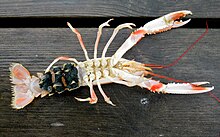ヨーロッパアカザエビ
| ヨーロッパアカザエビ | ||||||||||||||||||||||||||||||
|---|---|---|---|---|---|---|---|---|---|---|---|---|---|---|---|---|---|---|---|---|---|---|---|---|---|---|---|---|---|---|
 Cretaquariumで撮影
| ||||||||||||||||||||||||||||||
| 保全状況評価 [1] | ||||||||||||||||||||||||||||||
| LEAST CONCERN (IUCN Red List Ver.3.1 (2001)) 
| ||||||||||||||||||||||||||||||
| 分類 | ||||||||||||||||||||||||||||||
| ||||||||||||||||||||||||||||||
| 学名 | ||||||||||||||||||||||||||||||
| Nephrops norvegicus (Linnaeus, 1758) | ||||||||||||||||||||||||||||||
| シノニム | ||||||||||||||||||||||||||||||
| 英名 | ||||||||||||||||||||||||||||||
| Norway lobster Dublin Bay prawn、 Langoustine、 Scampi |
ヨーロッパアカザエビ (欧州藜海老、Nephrops norvegicus) は、アカザエビ科に属するエビの一種。体色は薄橙色で全長25 cm程度、ヨーロッパで最も重要な食用甲殻類である[5]。アカザエビ等の近縁種がアカザエビ属(Metanephrops)に移動されたため、ヨーロッパアカザエビ属唯一の現生種となっている。大西洋北東部・地中海に生息するが、バルト海・黒海では見られない。成体は巣穴の中で生活し、夜間に外に出て多毛類や魚類などを食べる。
英語ではノーウェイ・ロブスター(Norway lobster)やダブリン・ベイ・プローン(Dublin Bay prawn)、フランス語ではラングスティーヌ(langoustine)、イタリア語ではスカンポ(Scampo)やスカンピなどと呼ばれる。
形態
[編集]ウミザリガニに比べると細身であるが、その形態は典型的なアカザエビ科のものである[5]。体色は淡い橙で、通常は全長18-20 cm、最大で25 cmになる[6]。第1-3脚は鋏脚となるが、特に第1脚には棘があり大きい。2対の触角の内、第2触角は細く、長い[6]。額角は長く、棘がある。複眼は腎形で、ここからギリシャ語のνεφρός (nephros, "腎臓")・ops ("眼")に由来するNephropsという属名が付けられた[5]。
分布
[編集]大西洋北東部や北海に生息し、北はアイスランド・ノルウェーから南はポルトガルに及ぶ。アドリア海北部を除き、地中海には少ない[7][8]。黒海・バルト海には分布しない[5]。非常に細かい堆積物上に生息することから、分布はまばらで、30以上の個体群に分けられる。成体が数百メートルを超えて移動することは少ない[5]。
生態
[編集]
生息深度は20-800 m[9]。成体はシルト・粘土を40%以上含む泥底を好み[5]、巣穴を掘ってその中で生活する[10]。巣穴は通常深さ20-30 cm、長さ50-80 cmほどになり[5]、そこを離れるのは摂餌・繁殖の時だけである[5]。
餌
[編集]捕食者または腐肉食者であり[11]、夜間に巣穴から出て多毛類や魚類などを捕食する[12][13][14]。捕食には鋏脚や歩脚が用いられ、顎脚によって口に運ばれる[5]。
寄生生物
[編集]体表からは付着生物として、ハナフジツボ(Balanus crenatus)やCyclogyra属の有孔虫などが報告されているが、その数は他の十脚類に比べて少ない[15]。1995年12月、本種の口器から片利共生生物であるシンビオン属のパンドラムシ(Symbion pandora)が発見され、新しい門 (分類学)、有輪動物門が立てられた[16]。これに関してサイモン・コンウェイ・モリスは "ここ10年で最大の動物学的発見"と評している[17]。この生物は大西洋・地中海双方のヨーロッパアカザエビ個体群で見られ[18]、付着部位は大顎から第3顎脚に集中している[19]。
最も影響の大きい寄生虫はヘマトジニウム属(Hematodinium)の渦鞭毛藻で、1980年代から本種の漁獲量に影響を与えている[15]。この渦鞭毛藻は様々な十脚類に寄生するが、その分類は遅れている[15]。これが寄生することで背甲に色がついて不透明となるほか、血液が乳白色となり、瀕死になる。これらの症状は脱皮後症候群(post-moult syndrome)として知られる[15]。他の寄生虫としては、グレガリナの一種 Porospora nephropis ・吸虫の Stichocotyle nephropis ・エビヤドリゴカイ科の一種 Histriobdella homariなどがある[15]。
生活環
[編集]
寿命は5–10年だが[20]、最大で15年というデータもある[21]。成体は晩冬から春にかけて、雄は年に1-2回・雌は1回(卵の孵化後)脱皮する[5]。その後、雌の殻が軟らかい状態で交尾が行われる[22]。卵巣は夏に成熟し、初秋にかけて抱卵する。抱卵中の雌は、卵の孵化まで巣穴の中に留まる[5]。
生息域の南部では概ねこのような生活環を持つが、北部では多少異なる[5]。卵の孵化は水温が低いほど遅くなるため、高緯度では翌年の繁殖期までに卵を孵化させることができない。この場合、雌は1年おきに繁殖することになる[23]。
利用
[編集]
尾部はスキャンピとして食材となる。魚介類のパエリアには丸ごと用いられる。漁業上の重要種であり、トロール網などで年に60,000 t漁獲されるが、その半分はイギリスのEEZ内で漁獲されている[9]。
本種の漁業における廃棄率は非常に高いが、その廃棄物によりヌタウナギのような腐肉食者の餌の37%が賄われているというデータもある[24]。また、プレイスやタラなども大量に混獲されるが、これらの魚種による収入は漁の続行に不可欠だと考えられている[25]。
分類
[編集]| Nephrops norvegicusの外部識別子 | |
|---|---|
| Encyclopedia of Life | 128512 |
| ITIS | 97317 |
| NCBI | 6829 |
| WoRMS | 107254 |
| 次も参照: ウィキスピーシーズ、MarLIN & SeaLifeBase | |
カール・フォン・リンネの『自然の体系』第10版で記載された種の一つである。この際の学名は Cancer Norvegicus であり、模式産地はノルウェー海 (in Mari Norvegico) とされた[26]。その後レクトタイプの選定にあたって、リプケ・ホルトホイスはスウェーデン南部、カテガット海峡に面したクーレン半島 (北緯56度18分 東経12度28分 / 北緯56.300度 東経12.467度) に産した個体を選んだ[2]。シノニムの1つとして、1814年に地中海産の個体に対して命名された Astacus rugosus がある。
1814年にウィリアム・エルフォード・リーチによりヨーロッパアカザエビ属(Nephrops)が立てられ、本種はそこに移された[2][27]。その後、この属には7種の化石種が含められた[28]。
地中海の個体群は、変種 Nephrops norvegicus var. meridionalis Zariquiey, 1935 として分離されることもあるが、このタクソンは広く認められてはいない[5]。
脚注
[編集]- ^ C. Bell (2011). "Nephrops norvegicus". IUCN Red List of Threatened Species. Version 2011.2. International Union for Conservation of Nature. 2012年1月1日閲覧。
- ^ a b c Lipke B. Holthuis (1991). “Nephrops norvegicus”. FAO Species Catalogue, Volume 13. Marine Lobsters of the World. FAO Fisheries Synopsis No. 125. FAO. ISBN 92-5-103027-8
- ^ L. B. Holthuis (1954). “С. S. Rafinesque as a carcinologist: an annotated compilation of the information on Crustacea contained in the works of that author”. Zoologische Mededelingen 25 (1): 1–43.
- ^ Charles Spence Bate & Joshua Brooking Rowe (1880). “Second Report of the Committee, consisting of Mr. C. Spence Bate and Mr. J. Brooking Kowe, appointed for the purpose of exploring the Marine Zoology of South Devon”. Report of the Fiftieth Meeting of the British Association for the Advancement of Science. London: John Murray. pp. 160–161
- ^ a b c d e f g h i j k l m Mike C. Bell, Frank Redant & Ian Tuck (2006). “Nephrops Species”. In Bruce F. Phillips. Lobsters: Biology, Management, Aquaculture and Fisheries. Wiley-Blackwell. pp. 412–461. doi:10.1002/9780470995969.ch13. ISBN 978-1-4051-2657-1
- ^ a b “Norway lobster - Nephrops norvegicus”. Biodiversity and Conservation. Marine Life Information Network. December 1, 2010閲覧。
- ^ Alan Davidson (2002). Mediterranean Seafood. Ten Speed Press. ISBN 978-1-58008-451-2
- ^ “Nephrops norvegicus (Linnaeus, 1758)”. AdriaMed. FAO. 2012年9月18日閲覧。
- ^ a b “Nephrops norvegicus”. FAO: Fisheries Global Information System (FIGIS) (February 26, 2004). 2012年9月18日閲覧。
- ^ B. I. Dybern & T. Hoisaeter (1965). “The burrows of Nephrops norvegicus”. Sarsia 21: 49–55.
- ^ H. J. Thomas & C. Davidson (1962). “The food of the Norway lobster Nephrops norvegicus”. Marine Research 3: 1–15.
- ^ C. J. Chapman & A. L. Rice (1971). “Some direct observations on the ecology and behaviour of the Norway Lobster Nephrops norvegicus using different methods”. Marine Biology 10 (4): 321–329. doi:10.1007/BF00368092.
- ^ C. J. Chapman, A. D. F. Johnstone & A. L. Rice (1975). H. Barnes (ed.). The behaviour and ecology of the Norway lobster, Nephrops norvegicus. Proceedings of the 9th European Marine Biological Symposium. Aberdeen University Press. pp. 59–74.
- ^ J. C. Early. “Processing Norway lobsters”. FAO. March 18, 2007閲覧。
- ^ a b c d e Grant D. Stentiford & Douglas M. Neil (2011). Diseases of Nephrops and Metanephrops: a review. In Grant Stentiford. “Diseases of Edible Crustaceans”. Journal of Invertebrate Pathology 106 (1): 92–109. doi:10.1016/j.jip.2010.09.017. PMID 21215358.
- ^ Peter Funch & Reinhardt Kristensen (1995). “Cycliophora is a new phylum with affinities to Entoprocta and Ectoprocta”. Nature 378 (6558): 711–714. Bibcode: 1995Natur.378..711F. doi:10.1038/378711a0.
- ^ Robert Bradley Jackson (2002). “The richness of life”. The Earth Remains Forever: Generations at a Crossroads. University of Texas Press. pp. 15–62. ISBN 978-0-292-74055-6
- ^ Matteo Dal Zotto & M. Antonio Todaro (2008). Cycliophora. In G. Relini. “La checklist della flora e della fauna dei mari italiani” (PDF). Biologia Marina Mediterranea 15 (Suppl. 1): 178–181.
- ^ Matthias Obst & Peter Funch (2006). “The microhabitat of Symbion pandora (Cycliophora) on the mouthparts of its host Nephrops norvegicus (Decapoda: Nephropidae)”. Marine Biology 148 (5): 945–951. doi:10.1007/s00227-005-0131-1.
- ^ Marisa Sabatini & Jacqueline Hill (2008年). “Norway lobster - Nephrops norvegicus”. Marine Life Information Network. Marine Biological Association of the United Kingdom. February 14, 2011閲覧。
- ^ “Lobster research at IMR”. Norwegian Institute of Marine Research. 2012年9月18日閲覧。
- ^ A. S. D. Farmer (1975). Synopsis of data on the Norway lobster Nephrops norvegicus. FAO Fisheries Synopsis No. 112. FAO. pp. 1–97
- ^ N. Bailey (1984). Some Aspects of Reproduction in Nephrops. Shellfish Committee Document CM 1984/K:33. International Council for the Exploration of the Sea. p. 16
- ^ T. L. Catchpole, C. L. J. Frid & T. S. Gray (2006). “Importance of discards from the English Nephrops norvegicus fishery in the North Sea to marine scavengers”. Marine Ecology Progress Series 313: 215–226. doi:10.3354/meps313215.
- ^ Ivor Clucas (1997). “A study of the options for utilization of bycatch and discards from marine capture fisheries: 9.1.2 Nephrops”. FAO Fisheries Circular No. 928: FIIU/C928.
- ^ Carl Linnaeus (1758). “Cancer”. Systema Naturae (10th ed.). Stockholm: Laurentius Salvius. pp. 625–634
- ^ William Elford Leach (1830). "Crustaceology". In David Brewster (ed.). The Edinburgh Encyclopaedia. Vol. 7. pp. 383–437.
- ^ Sammy De Grave, N. Dean Pentcheff, Shane T. Ahyong et al. (2009). “A classification of living and fossil genera of decapod crustaceans”. Raffles Bulletin of Zoology Suppl. 21: 1–109.
外部リンク
[編集]- Nephrops norvegicus (Linnaeus, 1758), FAOADRIAMED
- FAO Species Fact Sheet
 ウィキメディア・コモンズには、ヨーロッパアカザエビに関するカテゴリがあります。
ウィキメディア・コモンズには、ヨーロッパアカザエビに関するカテゴリがあります。
